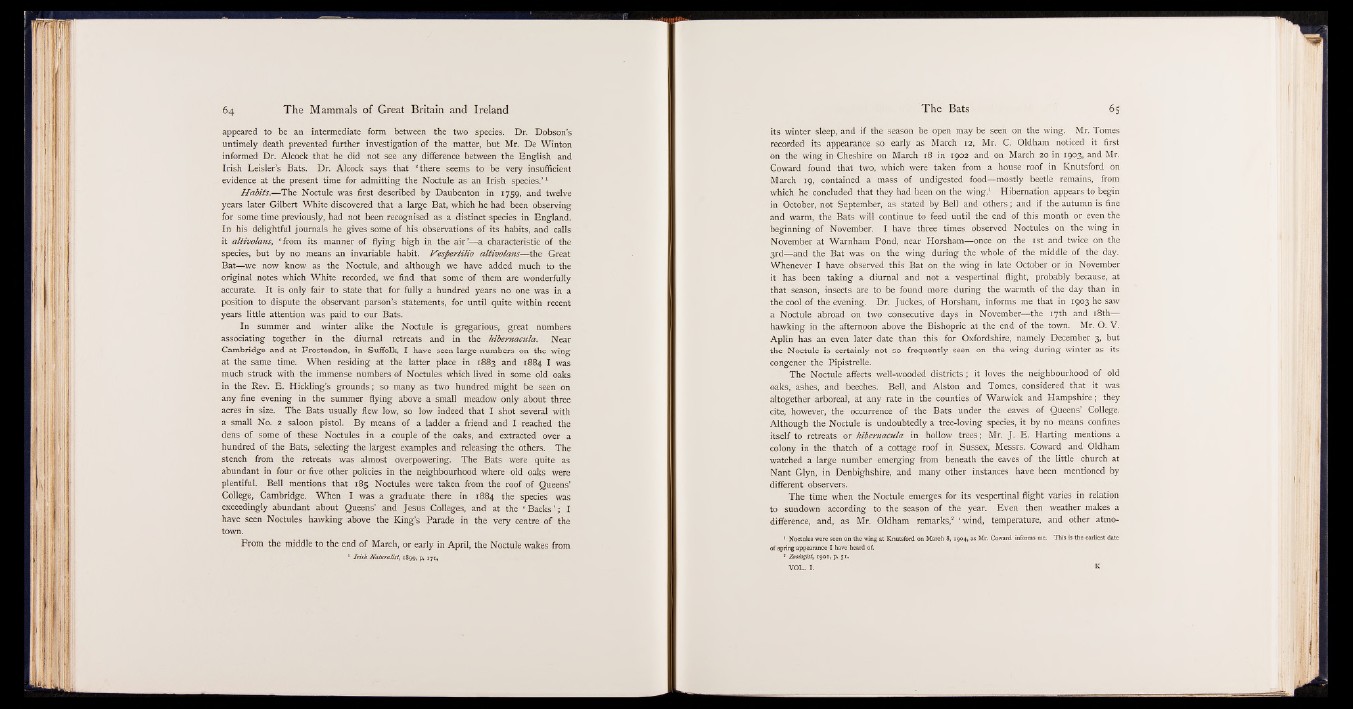
appeared to be an intermediate form between the two species. Dr. Dobson’s
untimely death prevented further investigation of the matter, but Mr. De Winton
informed Dr. Alcock that he did not see any difference between the English and
Irish Leisler’s Bats. Dr. Alcock says that ‘ there seems to be very insufficient
evidence at the present time for admitting the Noctule as an Irish species.’ 1
Habits.— The Noctule was first described by Daubenton in 1759, and twelve
years later Gilbert White discovered that a large Bat, which he had been observing
for some time previously, had not been recognised as a distinct species in England.
In his delightful journals he gives some of his observations of its habits, and calls
it altivolans, ‘ from its manner of flying high in the air’— a characteristic of the
species, but by no means an invariable habit. Vespertilio altivolans— the Great
Bat— we now know as the Noctule, and although we have added much to the
original notes which White recorded, we find that some of them are wonderfully
accurate. It is only fair to state that for fully a hundred years no one was in a
position to dispute the observant parson’s statements, for until quite within recent
years little attention was paid to our Bats.
In summer and winter alike the Noctule is gregarious, great numbers
associating together in the diurnal retreats and in the hibernacula. Near
Cambridge and at Frostendon, in Suffolk, I have seen large numbers on the wing
at the same time. When residing at the latter place in 1883 and 1884 I was
much struck with the immense numbers of Noctules which lived in some old oaks
in the Rev. E. Hickling’s grounds; so many as two hundred might be seen on
any fine evening in the summer flying above a small meadow only about three
acres in size. The Bats usually flew low, so low indeed that I shot several with
a small No. 2 saloon pistol. By means of a ladder a friend and I reached the
dens of. some of these Noctules in a couple of the oaks, and extracted over a
hundred of the Bats, selecting the largest examples and releasing the others. The
stench from the retreats was almost overpowering. The Bats were quite as
abundant in four or five other policies in the neighbourhood where old oaks were
plentiful. Bell mentions that 185 Noctules were taken from the roof of Queens’
College, Cambridge. When I was a graduate there in 1884 the species was
exceedingly abundant about Queens’ and Jesus Colleges, and at the ‘ Backs’ ; I
have seen Noctules hawking above the King’s Parade in the very centre of the
town.
From the middle to the end of March, or early in April, the Noctule wakes from
1 Irish Naturalist; 1899, p. 171,
its winter sleep, and if the season be open may be seen on the wing. Mr. Tomes
recorded its appearance so early as March 12, Mr. C. Oldham noticed it first
on the wing in Cheshire on March 18 in 1902 and on March 20 in 1903, and Mr.
Coward found that two, which were taken from a house roof in Knutsford on
March 19, contained a mass of undigested food—mostly beetle remains, from
which he concluded that they had been on the wing.1 Hibernation appears to begin
in October, not September, as stated by Bell and others; and if the autumn is fine
and warm, the Bats will continue to feed until the end of this month or even the
beginning of November. I have three times observed Noctules on the wing in
November at Warnham Pond, near Horsham— once on the 1st and twice on the
3rd— and the Bat was on the wing during the whole of the middle of the day.
Whenever I have observed this Bat on the wing in late October or in November
it has been taking a diurnal and not a vespertinal flight, probably because, at
that season, insects are to be found more during the warmth of the day than in
the cool of the evening. Dr. Juckes, of Horsham, informs me that in 1903 he saw
a Noctule abroad on two consecutive days in November— the 17th and i8th-§|
hawking in the afternoon above the Bishopric at the end of the town. Mr. O. V.
Aplin has an even later date than this for Oxfordshire, namely December 3, but
the Noctule is certainly not so frequently seen on the wing during winter as its
congener the Pipistrelle.
The Noctule affects well-wooded districts; it loves the neighbourhood of old
oaks, ashes, and beeches. Bell, and Alston and Tomes, considered that it was
altogether arboreal, at any rate in the counties of Warwick and Hampshire; they
cite, however, the occurrence of the Bats under the eaves of Queens’ College.
Although the Noctule is undoubtedly a tree-loving species, it by no means confines
itself to retreats or hibernacula in hollow trees; Mr. J. E. Halting mentions a
colony in the thatch of a cottage roof in Sussex, Messrs. Coward and Oldham
watched a large number emerging from beneath the eaves of the little church at
Nant Glyn, in Denbighshire, and many other instances have been mentioned by
different observers.
The time when the Noctule emerges for its vespertinal flight varies in relation
to sundown according to the season of the year. Even then weather makes a
difference, and, as Mr. Oldham remarks,2 ‘ wind, temperature, and other atmo-
1 Noctules were seen on the wing at Knutsford on March 8, 1904, as Mr. Coward informs me. This is the earliest date
of spring appearance I have heard of.
* Zoologist, 1901, p. 51.
VOL. I.